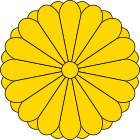- Ministry of Civil Services
-
Pre-modern Japan 
This article is part of the series:
Daijō-kan
Council of State- Chancellor or Chief Minister (Daijō-daijin)
- Minister of the Left (Sadaijin)
- Minister of the Right (Udaijin)
- Minister of the Center (Naidaijin)
- Major Counselor (Dainagon)
- Middle Counselor (Chūnagon)
- Minor Counselor (Shōnagon)
- Ministry of the Center (Nakatsukasa-shō)
- Ministry of Civil Services (Shikibu-shō)
- Ministry of Ceremonies (Jibu-shō)
- Ministry of Taxation (Minbu-shō)
- Ministry of the Military (Hyōbu-shō)
- Ministry of Justice (Gyōbu-shō)
- Ministry of the Treasury (Ōkura-shō)
- Ministry of the Imperial Household (Kunai-shō)
_____________________
Meiji government
_____________________
Postwar Shōwa period
- Imperial Household Agency (Kunaichō)
The Ministry of Civil Services (式部省 Shikibu-shō) was a division of the eighth century Japanese government of the Imperial Court in Kyoto,[1] instituted in the Asuka period and formalized during the Heian period. The Ministry was replaced in the Meiji period.
Contents
Overview
This part of the bureaucracy has been variously identified as the "Ministry of the Civil Services," the Ministry of Legislative Direction and Public Instruction.[2] and the Ministry of Civil Administration[3] or the Ministry of Rites.[4]
The Ministry's activities encompassed maintenance of the lists of civil officers, oversight of appointments to office and to rank (third grade and above) and stewards in the imperial palace, and administration of rewards for service. Additionally the ministry was an administrative body for schools and civil examinations, pensions, and donations. The ministry was tasked with maintaining the order of precedence of the various officials at the time of congratulatory occasions and of festivals.[5]
This ministry collected and maintained biographical archives of meritorious subjects.[6]
History
In 758, this ministry was renamed Mombushō. The original name was restored in 764;[4] and this name was unchanged until the ritsuryō system was abandoned during the Meiji period.
In the Edo period, titles related to the Shikibu-shō, such as Shikibu-dayū, were largely ceremonial and could be held by non-kuge, such as daimyō lords.
Hierarchy
The court hierarchy developed a Ministry of the Civil Services (式部省, Shikibu-shō);[2] also known as the "Ministry of Legislative Direction and Public Instruction".[3] This ministry collected and maintained biographical archives of meritorious subjects.[6] Amongst the significant Daijō-kan officials within this ministry structure were:
- Chief administrator of the ministry of civil services (式部卿 Shikibu-kyō);[7] also known as Chief minister of public instruction. This office is ordinarily filled by a son or close relative of the emperor. There are seven judges who directly assist this court official:[8]
- Chief judge (式部大輔 Shikibu-taifu)[8]
- Chief Education expert (大学頭 Daigaku-no-kami)[8]
- Chief experts on the history of Japan and China (紀伝博士 Kiden-hakase)[8]
- Chief experts on classical Chinese works (明経博士 Myōgyō-hakase)[8]
- Chief experts on jurisprudence of Japan and China' (明法博士 Myōbō-hakase)[8]
- Chief experts on mathematics (算博士 San-hakase)[8]
- Chief calligrapher of the court (文章博士 'Monjō-hakase). There would have been many copyist calligraphers working under the direction of the chief calligrapher[8]
- First Assistant to the chief calligrapher of the court (助教 Jokyō)[8]
- Instructors of Japanese and Chinese literature (直講 Chok'kō), two positions[8]
- Instructors in pronunciation of words (音博士 On-hakase), two positions[8]
- Instructors in calligraphy (書博士 Sho-hakase), two positions[8]
See also
Notes
- ^ Kawakami, Karl Kiyoshi. (1903). The Political Ideas of the Modern Japan, pp. 36-38. at Google Books
- ^ a b Titsingh, Isaac. (1834). Annales des empereurs du japon, p. 427 at Google Books
- ^ a b Ministry of Civil Administration, Sheffield.
- ^ a b Nussbaum, Louis Frédéric et al. (2005). "Shikibushō" in Japan Encyclopedia, p. 856. at Google Books
- ^ Kawakami, p. 37 n2, at Google Books citing Ito Hirobumi, Commentaries on the Japanese Constitution, p. 86 (1889).
- ^ a b Ury, Marian. (1999). "Chinese Learning and Intellectual Life," The Cambridge History of Japan: Heian Japan, p. 361.
- ^ Varley, H. Paul. (1980). Jinnō Shōtōki, p. 272.
- ^ a b c d e f g h i j k l m n o p q r Titsingh, p. 428 at Google Books
References
- Kawakami, Karl Kiyoshi. (1903). The Political Ideas of the Modern Japan. Iowa City, Iowa: University of Iowa Press. OCLC 466275784. Internet Archive, full text
- Nussbaum, Louis Frédéric and Käthe Roth. (2005). Japan Encyclopedia. Cambridge: Harvard University Press. 10-ISBN 0-674-01753-6; 13-ISBN 978-0-674-01753-5; OCLC 48943301
- Titsingh, Isaac. (1834). Nihon Odai Ichiran; ou, Annales des empereurs du Japon. Paris: Royal Asiatic Society, Oriental Translation Fund of Great Britain and Ireland. OCLC 5850691
- Ury, Marian. (1999). "Chinese Learning and Intellectual Life," The Cambridge history of Japan: Heian Japan. Vol. II. Cambridge: Cambridge University Press. 10-ISBN 0521223539/ 13-ISBN 9780521223539
- Varley, H. Paul. (1980). Jinnō Shōtōki: A Chronicle of Gods and Sovereigns. New York: Columbia University Press. 10-ISBN 0-231-04940-4; 13-ISBN 978-0-231-04940-5; OCLC 59145842
Categories:- Government of feudal Japan
- Meiji Restoration
- Government ministries of Japan
- Former ministries
Wikimedia Foundation. 2010.
